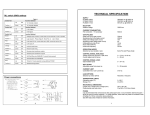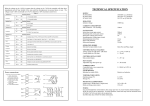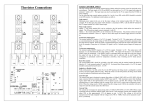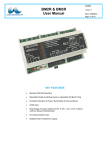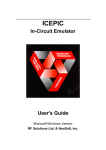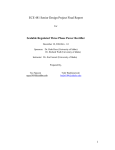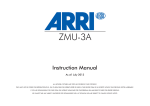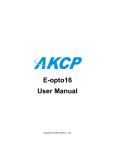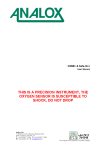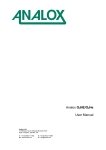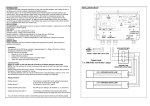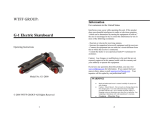Download User Manual
Transcript
United Automation Ltd – Putting You in Control The FC36M is just one of many quality, reliable and cost effective power control products that UAL offer. UAL Product Portfolio UAL Product Applications Power Supplies to Specification Heaters Automatic Control Systems for Heating, Ventilation and Ovens Air Conditioning Systems Stress Relieving Thyristor or Operated Systems Lighting Equipment Electronic Controls for Heating Systems Power Supplies Thyristor Phase Control Products Furnaces Microprocessor based Water Heating Controllers Vats Command & Control Systems Trace Heating Modular High Voltage Power Supplies Annealing Electronic Temperature Controllers Vibrators Automatic Control Systems for Controlled Atmosphere Dryers Furnaces Extruders Automation Control Systems for Glass and Ceramics Smelting Manufacturing Plating Solid State Power Supplies for Electroplating Electromagnets Triacs Voltage Controlled Motors Semiconductor Controlled Rectifier Stacks Pipe Heating Thyristor Trigger Modules Process Heating Electronic Assemblies Vending Machines Solar Heating Automatic Control Systems Space Heating Solid State Relays Lamp Loads Digital Energy Modules Blenders Fuses Mixers Filters (Single and 3 Phase) Pumps Quartz Lamps Fans Built to ISO 9002 and EMC quality Standards, our extensive We are extremely proud of, and strongly defend, our range of power controllers and spares are probably the most reputation of having one of the best and fastest response competitively priced on the market and are available directly rates to customers’ specific requirements from our considerable stock resources Our only priority is to keep you, our customer satisfied. Our next day delivery service also ensures that we can solve Our job is not just to solve your power control problems your power control problems as they occur. but to serve you until you are totally satisfied. Our total service concept ensures that our customer service staff are Whilst standard designs are available to our customers, we always available to help you in a courteous and also work in close conjunction with them to develop professional manner customised products to suit their needs exactly No matter how large the company is or the size of the order, you can be assured that we will give it our undivided attention. 1 Southport Business Park, Kew, Southport, PR8 4HQ Tel: 01704 516500 Fax: 01704 516501 [email protected] Three Phase Firing Board Model – FC36M User Manual X10283 Issue 4 29/06/00 Three Phase Firing Board Model – FC36M This manual should familiarise the user with the relevant features and specifications of the FC36M firing board and incorporates a simple checkout procedure with typical connection diagrams RECOMMENDATION Other documents available on request, which may be appropriate for your applications. General information CODE X10229 X10213 X10255 IDENTITY RFI ITA SRA X10378 ILR AP02/4 COS The FC36M is a microprocessor version of the industry standard FC36A originally developed in the 1980’s. It is smaller in size than it’s predecessor with reduced component count, which increases its reliability. It also has more options available with the selections on a six way DIL switch making it much more versatile and economical. It also has an integral supply and timing transformer, which is used as a Phase reference. The FC36M is a general purpose Phase Angle and Burst Firing circuit designed to be used in a variety of two or three, phase 50/60 Hz applications. It can also be used as a Three single phases to Neutral controller. It is easily configured, by the user, to optimise its performance, which is achieved primarily by the use of DIL, switches. To make a complete three phase controller, the FC36M requires power devices, protection fuses and a suitable heatsink. It can be used for driving three phase transformer primaries in either star, delta or phase to neutral configurations and can also be configured to control either three phase, half or fully controlled, thyristor bridges. DESCRIPTION Filtering recommendation - addressing EMC directive. Interaction, uses for phase angle and for burst fire control. Safety requirements - addressing the Low Voltage Directive (LVD) including :-Thermal data/cooling ; “Live” parts warning & Earth requirements; Fusing recommendations. Inductive loads remedies sheet for use with Phase angle controllers. UAL Conditions of sale NOTE It is recommended that installation and maintenance of this equipment should be done with reference to the current edition of the I.E.E. Wiring Regulations (BS7671) by suitably qualified/trained personnel. The regulations contain important requirements regarding safety of electrical equipment. (For International Standards refer to I.E.C. Directive I.E.C. 950). It may be used on resistive loads (phase to phase or phase to neutral) using burst fire or phase angle, or a combination of both firing modes. Its analogue signal inputs can be used in conjunction with each other, to set two different output levels. The logic optocoupled inputs allow for remote control in electrically noisy environments. There are two current set points – the lower one is used for current control and the upper limit, when tripped, will cause the unit to latch in the off state. The firing circuit is based around the PIC16C74 Microprocessor, generating six controlled thyristor gate pulses nominally displaced by 60°. It can be controlled by either 0 to 5v or 4 – 20mA analogue signals or remote 5 to 24 volts DC logic signals. The logic inputs also provide remote soft start, soft stop and switching from Phase Angle to Burst Fire either manual or automatically Its compact size (160mm wide, 100mm high and 40mm deep) allows OEM’s to easily incorporate the FC36M into their product design and end users can update existing equipment very quickly with little development costs. It can also be supplied with DIN rail mounting enclosure. 2 11 Application Twelve Pulse Connections • • • • • • • • • Power Supplies Half and Fully controlled Rectifiers AC Motor Control DC Motor Control Soft Starters Heater Controllers Induction Generator AC Voltage Regulation Three Phase Transformer Control Additional Firing boards can be configured to trigger paralleled SCR’s for very high current applications or to provide a twelve pulse driver for smooth DC control Key Features Thyristors require a high initial gate current pulse and comparatively wide sustaining pulses to ensure reliable firing, particularly at small phase control angles. The FC36M provides the following firing specifications • Gate Drive: Picket Fence with a PRF of 25Khz an initial firing pulse of; 8 volts open circuit. 800 mA into 1 Ohm, and sustaining pulses 400mA into 1 Ohm per output. The sustaining pulses are 20 uS Wide. • High output initial triggering pulses • Gate isolation to 3500 V rms. • Adjustable Soft start and soft start times • Selectable hard start and hard stop • 50/60 Hz operation auto selection • Remote Logic input for control in noisy environment 524 V dc • Two analogue control inputs 0-5 V dc and 4-20mA • Current control input 0-100 mV • Over-current limit trip (Latching) • Adjustable ramp control 0-30 seconds • Pre-selectable or automatic Phase Angle to Burst Fire control • Switchable Phase reversal • Selectable Inductive or Resistive load setting • Selectable timing delay for use as a twelve pulse driver • High immunity to mains voltage distortions • Complete with integral phasing and supply transformer. OPERATING INSTRUCTIONS APPLICATIONS The firing circuit responds to voltage or milliamp current signals to produce six 60° spaced high current thyristor gate pulses. Additional boards can be configured for high current parallel gating of additional thyristors and for twelve pulse converters (rectifiers). CONNECTIONS The Gate and Cathode outputs have 6.3mm blade terminals. All other connections are made with captive screw and leaf terminal blocks. 0.25mm header connections are provided to connect firing boards for paralleled thyristor drive or 12 pulse configuration. Note: - J1 Jumper reverses pulse transformer outputs. LED INDICATION Three LED’s are used for status and fault indication. The LED1 (green) is situated in the centre of the board and illuminates when the 5 volts dc supply is present. When SW2 position No 2 is ON, LED 2 (red) will illuminate when the LIMIT input has reached the level set by (I SET) LED 2 and LED 3 (orange) will alternately flash on a 1 second timebase when the LIMIT input exceeded the value set by VR1 (I TRIP). The FC36M will shut down and will stay latched in this statue until the microprocessor is powered down or reset. Under normal conditions LED 3 is used to indicate the output status. In phase Angle mode, when the control signal is increased, so does the brightness of LED 3. In Burst Fire mode LED 3 will pulse on a one second timebase with a variable mark space (on-off) ratio determined by the control signal. ANALOGUE CONTROL INPUTS For the following analogue control options the 6 way DIL switch (SW2) should have position No.1 switched to the ON position. For additional control options see table A on page 6 of this manual. 10 3 Manual Control The FC36M firing circuit has a 0 to 5V dc output that can be used to supply the clockwise end of a 5K ohm potentiometer. The wiper is connected to the terminal marked 0-5V and the counterclockwise end to 0V. Voltage control For control using a remote 0–5V dc signal requires the positive input to be connected to the terminal marked 0-5V and the negative input to be connected to 0V. The input impedance is 10K ohms. Current control For current control, connect a 4-20 mA dc signal between terminals marked 4-20 mA and 0V. This input can also be used as 1-5V dc input. The input impedance is 240 ohms. Phase Angle control Option 1 - the switch marked SW1 can be switched to the analogue position. This position connects terminals A with 5V and C with 0V. Option 2 – (see Soft Starting) the switch marked SW1 can be switched to the OFF position. The OFF position isolates the inputs and disconnects terminals A from 5V and C from 0V. Inputs (A and C) then require an external supply between 5 and 24 volts dc. Burst Firing control The switch marked SW1 should be switched OFF position and the terminal marked B should be linked to 5V and terminal C linked to 0V. Link terminals marked 5V and 0-5V. Phase Angle to Burst Firing control The switch marked SW1 should be switched to the analogue ON position and terminals A and B should be linked together. The firing circuit will start in phase angle mode and switch to burst mode when the control signal ramps up to the set point. It will stay in the burst mode even if the signal drops below the set point. It will restart in phase angle mode when the unit is switched off or reset. Soft Start When the FC36M is initially powered up the output is inhibited for 0.5 seconds, then the soft start is automatically enabled and the firing circuit will ramp up at a rate determined by VR3 (0-30 seconds). The ramp time relates to full conduction, for example if the ramp time is set to maximum (30 seconds) and the set point is 50% the controller will ramp to the set point in 15 seconds. Soft Stop and Soft Start after power up Soft Stop after power up can be achieved when a 5 to 24 volt dc signal is applied to the DOWN input with 0 volts being connected to terminal C. SW2 position No.5 should be turn ON. The firing circuit will soft stop (ramp down) at a rate determined by the setting of VR3. Whilst the signal is present it will remain in the off state until the signal is removed. When the signal is removed it will Soft Start and ramp up to the set point at a rate determined by VR3. Hard Stop and Hard Start after power up Hard Start and Hard Stop after power up can only be achieved with the switch marked SW1 in the OFF position. When A or B inputs are enabled or disabled and SW2 position No.5 is in the OFF state, the firing circuit will immediately turn on and off. 4 9 Thyristor Connections LOGIC CONTROL INPUT The logic control inputs are optically isolated and are ideally utilised for remote control in electrically noisy environments. The logic inputs A, B, UP and DOWN are activated by a 5 to 24 V dc signal with the respect to terminal C which is 0 volts. Terminal C and OV are not connected together when SW1 is in the OFF position. The logic input can also be activated by the 5V dc output from the FC36M via relay switching. Terminal C and OV should also be connected together. For the following logic control options the 6 way DIL switch (SW2) should have position No.1 switched to the OFF position. For additional control options see table A. Logic control Maximum power output levels are set by, the input voltage at the terminal marked 0-5V. With, for example, 4 volts on this input, the output will be limited to a maximum of 80%. Link the 0-5V input to 5V output terminal for 0-100% control range. Phase Angle control Option 1 – the switch marked SW1 can be switched to the ON position, which utilises the internal 5 volts supply. This ON position simply connects terminals A with 5V and C with 0V. Option 2 – the switch marked SW1 can be switched to the LOGIC or OFF position. The position isolates the inputs and disconnects terminals A from 5V and C from 0V. Inputs (A and C) then require external supply between 5 and 24volts dc. To Increase output power The terminal marked UP requires a 5 to 24 volts dc supply. Terminal C is 0 volts. The output power will increase at a rate determined by the ramp setting on VR3 (0-30 seconds). The output will reach its maximum when the ramp time has elapsed. If the UP signal is terminated during the ramp time the output will remain at that level, for example, if ramp time is 10 seconds. UP signal is on for 5 seconds, power output will ramp up to 50%. To decrease output power The terminal marked DOWN and C require a 5 to 24 volt dc supply. Terminal C is 0 volts. The output power will decrease at a rate determined by the ramp setting of VR3. The output will decrease to zero should the DOWN signal be maintained. If the DOWN signal is interrupted before the ramp down time has elapsed the output will stay at that level. Proportional control can be achieved with an on/off signal. This arrangement is particularly useful for temperature controllers, relay switching and PC based process controllers. Burst Fire control The switch marked SW1 should be switched to the OFF position and the terminal marked B should be linked to 5V and C (common) linked to the 0v terminal. Link terminals marked 5V and 0-5V. For remote Burst Firing control a 5 to 24V dc signal should be connected between B and C. C is 0 volts but is not internally connected to the 0V indicated on the pcb. Inductive or Resistive loads With switch No.3 on DIL switch No.2 in the OFF position the firing circuit configured to control resistive and some slightly inductive loads. When the switch is in the ON position the firing circuit should be used on inductive (transformer and coil) type loads. Current Limit The current limit input is designed to operate from 0-100mV dc input connected between terminals marked LIMIT input and 0V. This 100mV signal is amplified by IC7 and gives approximately 4 volts dc at pin 1. This voltage is fed into the microprocessor IC5 and compared with the voltage set by VR2 (I SET) which can be measured on pin 5 (IC5). When the voltage on pin 1 (IC7) is greater than the voltage on pin 5 (IC5), the controller will start to ramp down until the current reaches the I SET level. Current Trip The current trip input is designed to operate from 0-100mV dc input connected between terminals marked 5 8 LIMIT input and 0V. This 100mV signal is amplified by IC7 and gives approximately 4 volts dc at pin 1. This voltage is fed into the microprocessor IC5 and compared with the voltage set by VR1 (I TRIP) which can be measured on pin 7 (IC5). When the voltage on pin 1 (IC7) is greater than the voltage on pin 7 (IC5) the controller will shut down immediately and will stay latched in this state until the microprocessor is powered down or reset. The voltage on pin 7 (IC5) is normally set to 4.8 volts to allow for a 120% maximum current level. Switch No.2 Brown Position 1 Red Table A Function Selected Up On Analogue input, 0-5Vdc and 4-20 mA and SW1 in On position Down Off Logic inputs A=Phase Angle, B=Burst Fire, U=Up, D=Down Up On Limit input 0-100 mV, Current Limit Set by VR2 Position 2 Orange Down Off Limit input off Up On Inductive load timing Position 3 Yellow Down Off Resistive load timing Up On Reverse phasing Blue O/P1 Yellow O/P2 Red O/P3 Down Off Normal phasing Red O/P1 Yellow O/P2 Blue O/P3 Up On Soft stop and start when DOWN input is enabled or disabled Position 4 Green Position 5 Blue Down Off Hard start and stop when inputs A or B are enabled or disabled Up On Timing for 12 pulse operation using additional FC36M Position 6 Down Off Standard timing position TECHNICAL SPECIFICATION Supply Primary supply voltage using Integral transformer Secondary voltage Isolation voltage 380/415 V ac 50/60 Hz 20 V ac 50/60 Hz 4000V rms CURRENT CONSUMPTION Full condition 300 mA GATE PULSES Initial short circuit gate current Sustaining short circuit gate current Initial pulse voltage (open circuit) Sustaining pulse voltage (open circuit) Initial gate pulse rate of rise (A/uS) Pulse width 50/60 Hz Pulse train frequency 1A 0.5A 15V 8V 1 22uS 25 Khz OPERATION MODES Selection by input enable or auto Burst Fire and Phase Angle CONTROL SIGNAL ANALOGUE Voltage signal into 10K ohms Current signal into 240 ohms 0 – 5 V dc 4 – 20 mA CONTROL SIGNAL LOGIC Opto-isolated inputs 5 – 25 V dc SOFT START Adjustable range from power up 0 – 30 seconds CURRENT LIMIT Controlled limit or over-current trip 0 –100mV dc LOAD OPTIONS Selection by switch (SW2) Power connections Resistive or Inductive TEMPERATURE LIMITS Operating range (°C) Storage (°C) 0 - 65°C -20 to 85°C MECHANICAL DIMENSIONS Length (mm) x Width (mm) x Height (mm) Fixing Centres (mm) 160 x 100 x 36 150 x 62 FUSING It is recommended to use semiconductor (fast acting) type fuses or circuit breakers (Semiconductors – MCB) for unit protection. On initial ‘switch on’ some loads may need an increased Factor of Safety (F of S) for unit and/or device protection. (See SRA Datasheet for further information) 7 6 LIMIT input and 0V. This 100mV signal is amplified by IC7 and gives approximately 4 volts dc at pin 1. This voltage is fed into the microprocessor IC5 and compared with the voltage set by VR1 (I TRIP) which can be measured on pin 7 (IC5). When the voltage on pin 1 (IC7) is greater than the voltage on pin 7 (IC5) the controller will shut down immediately and will stay latched in this state until the microprocessor is powered down or reset. The voltage on pin 7 (IC5) is normally set to 4.8 volts to allow for a 120% maximum current level. Switch No.2 Brown Position 1 Red Table A Function Selected Up On Analogue input, 0-5Vdc and 4-20 mA and SW1 in On position Down Off Logic inputs A=Phase Angle, B=Burst Fire, U=Up, D=Down Up On Limit input 0-100 mV, Current Limit Set by VR2 Position 2 Orange Down Off Limit input off Up On Inductive load timing Position 3 Yellow Down Off Resistive load timing Up On Reverse phasing Blue O/P1 Yellow O/P2 Red O/P3 Down Off Normal phasing Red O/P1 Yellow O/P2 Blue O/P3 Up On Soft stop and start when DOWN input is enabled or disabled Position 4 Green Position 5 Blue Down Off Hard start and stop when inputs A or B are enabled or disabled Up On Timing for 12 pulse operation using additional FC36M Position 6 Down Off Standard timing position TECHNICAL SPECIFICATION Supply Primary supply voltage using Integral transformer Secondary voltage Isolation voltage 380/415 V ac 50/60 Hz 20 V ac 50/60 Hz 4000V rms CURRENT CONSUMPTION Full condition 300 mA GATE PULSES Initial short circuit gate current Sustaining short circuit gate current Initial pulse voltage (open circuit) Sustaining pulse voltage (open circuit) Initial gate pulse rate of rise (A/uS) Pulse width 50/60 Hz Pulse train frequency 1A 0.5A 15V 8V 1 22uS 25 Khz OPERATION MODES Selection by input enable or auto Burst Fire and Phase Angle CONTROL SIGNAL ANALOGUE Voltage signal into 10K ohms Current signal into 240 ohms 0 – 5 V dc 4 – 20 mA CONTROL SIGNAL LOGIC Opto-isolated inputs 5 – 25 V dc SOFT START Adjustable range from power up 0 – 30 seconds CURRENT LIMIT Controlled limit or over-current trip 0 –100mV dc LOAD OPTIONS Selection by switch (SW2) Power connections Resistive or Inductive TEMPERATURE LIMITS Operating range (°C) Storage (°C) 0 - 65°C -20 to 85°C MECHANICAL DIMENSIONS Length (mm) x Width (mm) x Height (mm) Fixing Centres (mm) 160 x 100 x 36 150 x 62 FUSING It is recommended to use semiconductor (fast acting) type fuses or circuit breakers (Semiconductors – MCB) for unit protection. On initial ‘switch on’ some loads may need an increased Factor of Safety (F of S) for unit and/or device protection. (See SRA Datasheet for further information) 7 6 Thyristor Connections LOGIC CONTROL INPUT The logic control inputs are optically isolated and are ideally utilised for remote control in electrically noisy environments. The logic inputs A, B, UP and DOWN are activated by a 5 to 24 V dc signal with the respect to terminal C which is 0 volts. Terminal C and OV are not connected together when SW1 is in the OFF position. The logic input can also be activated by the 5V dc output from the FC36M via relay switching. Terminal C and OV should also be connected together. For the following logic control options the 6 way DIL switch (SW2) should have position No.1 switched to the OFF position. For additional control options see table A. Logic control Maximum power output levels are set by, the input voltage at the terminal marked 0-5V. With, for example, 4 volts on this input, the output will be limited to a maximum of 80%. Link the 0-5V input to 5V output terminal for 0-100% control range. Phase Angle control Option 1 – the switch marked SW1 can be switched to the ON position, which utilises the internal 5 volts supply. This ON position simply connects terminals A with 5V and C with 0V. Option 2 – the switch marked SW1 can be switched to the LOGIC or OFF position. The position isolates the inputs and disconnects terminals A from 5V and C from 0V. Inputs (A and C) then require external supply between 5 and 24volts dc. To Increase output power The terminal marked UP requires a 5 to 24 volts dc supply. Terminal C is 0 volts. The output power will increase at a rate determined by the ramp setting on VR3 (0-30 seconds). The output will reach its maximum when the ramp time has elapsed. If the UP signal is terminated during the ramp time the output will remain at that level, for example, if ramp time is 10 seconds. UP signal is on for 5 seconds, power output will ramp up to 50%. To decrease output power The terminal marked DOWN and C require a 5 to 24 volt dc supply. Terminal C is 0 volts. The output power will decrease at a rate determined by the ramp setting of VR3. The output will decrease to zero should the DOWN signal be maintained. If the DOWN signal is interrupted before the ramp down time has elapsed the output will stay at that level. Proportional control can be achieved with an on/off signal. This arrangement is particularly useful for temperature controllers, relay switching and PC based process controllers. Burst Fire control The switch marked SW1 should be switched to the OFF position and the terminal marked B should be linked to 5V and C (common) linked to the 0v terminal. Link terminals marked 5V and 0-5V. For remote Burst Firing control a 5 to 24V dc signal should be connected between B and C. C is 0 volts but is not internally connected to the 0V indicated on the pcb. Inductive or Resistive loads With switch No.3 on DIL switch No.2 in the OFF position the firing circuit configured to control resistive and some slightly inductive loads. When the switch is in the ON position the firing circuit should be used on inductive (transformer and coil) type loads. Current Limit The current limit input is designed to operate from 0-100mV dc input connected between terminals marked LIMIT input and 0V. This 100mV signal is amplified by IC7 and gives approximately 4 volts dc at pin 1. This voltage is fed into the microprocessor IC5 and compared with the voltage set by VR2 (I SET) which can be measured on pin 5 (IC5). When the voltage on pin 1 (IC7) is greater than the voltage on pin 5 (IC5), the controller will start to ramp down until the current reaches the I SET level. Current Trip The current trip input is designed to operate from 0-100mV dc input connected between terminals marked 5 8 Manual Control The FC36M firing circuit has a 0 to 5V dc output that can be used to supply the clockwise end of a 5K ohm potentiometer. The wiper is connected to the terminal marked 0-5V and the counterclockwise end to 0V. Voltage control For control using a remote 0–5V dc signal requires the positive input to be connected to the terminal marked 0-5V and the negative input to be connected to 0V. The input impedance is 10K ohms. Current control For current control, connect a 4-20 mA dc signal between terminals marked 4-20 mA and 0V. This input can also be used as 1-5V dc input. The input impedance is 240 ohms. Phase Angle control Option 1 - the switch marked SW1 can be switched to the analogue position. This position connects terminals A with 5V and C with 0V. Option 2 – (see Soft Starting) the switch marked SW1 can be switched to the OFF position. The OFF position isolates the inputs and disconnects terminals A from 5V and C from 0V. Inputs (A and C) then require an external supply between 5 and 24 volts dc. Burst Firing control The switch marked SW1 should be switched OFF position and the terminal marked B should be linked to 5V and terminal C linked to 0V. Link terminals marked 5V and 0-5V. Phase Angle to Burst Firing control The switch marked SW1 should be switched to the analogue ON position and terminals A and B should be linked together. The firing circuit will start in phase angle mode and switch to burst mode when the control signal ramps up to the set point. It will stay in the burst mode even if the signal drops below the set point. It will restart in phase angle mode when the unit is switched off or reset. Soft Start When the FC36M is initially powered up the output is inhibited for 0.5 seconds, then the soft start is automatically enabled and the firing circuit will ramp up at a rate determined by VR3 (0-30 seconds). The ramp time relates to full conduction, for example if the ramp time is set to maximum (30 seconds) and the set point is 50% the controller will ramp to the set point in 15 seconds. Soft Stop and Soft Start after power up Soft Stop after power up can be achieved when a 5 to 24 volt dc signal is applied to the DOWN input with 0 volts being connected to terminal C. SW2 position No.5 should be turn ON. The firing circuit will soft stop (ramp down) at a rate determined by the setting of VR3. Whilst the signal is present it will remain in the off state until the signal is removed. When the signal is removed it will Soft Start and ramp up to the set point at a rate determined by VR3. Hard Stop and Hard Start after power up Hard Start and Hard Stop after power up can only be achieved with the switch marked SW1 in the OFF position. When A or B inputs are enabled or disabled and SW2 position No.5 is in the OFF state, the firing circuit will immediately turn on and off. 4 9 Application Twelve Pulse Connections • • • • • • • • • Power Supplies Half and Fully controlled Rectifiers AC Motor Control DC Motor Control Soft Starters Heater Controllers Induction Generator AC Voltage Regulation Three Phase Transformer Control Additional Firing boards can be configured to trigger paralleled SCR’s for very high current applications or to provide a twelve pulse driver for smooth DC control Key Features Thyristors require a high initial gate current pulse and comparatively wide sustaining pulses to ensure reliable firing, particularly at small phase control angles. The FC36M provides the following firing specifications • Gate Drive: Picket Fence with a PRF of 25Khz an initial firing pulse of; 8 volts open circuit. 800 mA into 1 Ohm, and sustaining pulses 400mA into 1 Ohm per output. The sustaining pulses are 20 uS Wide. • High output initial triggering pulses • Gate isolation to 3500 V rms. • Adjustable Soft start and soft start times • Selectable hard start and hard stop • 50/60 Hz operation auto selection • Remote Logic input for control in noisy environment 524 V dc • Two analogue control inputs 0-5 V dc and 4-20mA • Current control input 0-100 mV • Over-current limit trip (Latching) • Adjustable ramp control 0-30 seconds • Pre-selectable or automatic Phase Angle to Burst Fire control • Switchable Phase reversal • Selectable Inductive or Resistive load setting • Selectable timing delay for use as a twelve pulse driver • High immunity to mains voltage distortions • Complete with integral phasing and supply transformer. OPERATING INSTRUCTIONS APPLICATIONS The firing circuit responds to voltage or milliamp current signals to produce six 60° spaced high current thyristor gate pulses. Additional boards can be configured for high current parallel gating of additional thyristors and for twelve pulse converters (rectifiers). CONNECTIONS The Gate and Cathode outputs have 6.3mm blade terminals. All other connections are made with captive screw and leaf terminal blocks. 0.25mm header connections are provided to connect firing boards for paralleled thyristor drive or 12 pulse configuration. Note: - J1 Jumper reverses pulse transformer outputs. LED INDICATION Three LED’s are used for status and fault indication. The LED1 (green) is situated in the centre of the board and illuminates when the 5 volts dc supply is present. When SW2 position No 2 is ON, LED 2 (red) will illuminate when the LIMIT input has reached the level set by (I SET) LED 2 and LED 3 (orange) will alternately flash on a 1 second timebase when the LIMIT input exceeded the value set by VR1 (I TRIP). The FC36M will shut down and will stay latched in this statue until the microprocessor is powered down or reset. Under normal conditions LED 3 is used to indicate the output status. In phase Angle mode, when the control signal is increased, so does the brightness of LED 3. In Burst Fire mode LED 3 will pulse on a one second timebase with a variable mark space (on-off) ratio determined by the control signal. ANALOGUE CONTROL INPUTS For the following analogue control options the 6 way DIL switch (SW2) should have position No.1 switched to the ON position. For additional control options see table A on page 6 of this manual. 10 3 Three Phase Firing Board Model – FC36M This manual should familiarise the user with the relevant features and specifications of the FC36M firing board and incorporates a simple checkout procedure with typical connection diagrams RECOMMENDATION Other documents available on request, which may be appropriate for your applications. General information CODE X10229 X10213 X10255 IDENTITY RFI ITA SRA X10378 ILR AP02/4 COS The FC36M is a microprocessor version of the industry standard FC36A originally developed in the 1980’s. It is smaller in size than it’s predecessor with reduced component count, which increases its reliability. It also has more options available with the selections on a six way DIL switch making it much more versatile and economical. It also has an integral supply and timing transformer, which is used as a Phase reference. The FC36M is a general purpose Phase Angle and Burst Firing circuit designed to be used in a variety of two or three, phase 50/60 Hz applications. It can also be used as a Three single phases to Neutral controller. It is easily configured, by the user, to optimise its performance, which is achieved primarily by the use of DIL, switches. To make a complete three phase controller, the FC36M requires power devices, protection fuses and a suitable heatsink. It can be used for driving three phase transformer primaries in either star, delta or phase to neutral configurations and can also be configured to control either three phase, half or fully controlled, thyristor bridges. DESCRIPTION Filtering recommendation - addressing EMC directive. Interaction, uses for phase angle and for burst fire control. Safety requirements - addressing the Low Voltage Directive (LVD) including :-Thermal data/cooling ; “Live” parts warning & Earth requirements; Fusing recommendations. Inductive loads remedies sheet for use with Phase angle controllers. UAL Conditions of sale NOTE It is recommended that installation and maintenance of this equipment should be done with reference to the current edition of the I.E.E. Wiring Regulations (BS7671) by suitably qualified/trained personnel. The regulations contain important requirements regarding safety of electrical equipment. (For International Standards refer to I.E.C. Directive I.E.C. 950). It may be used on resistive loads (phase to phase or phase to neutral) using burst fire or phase angle, or a combination of both firing modes. Its analogue signal inputs can be used in conjunction with each other, to set two different output levels. The logic optocoupled inputs allow for remote control in electrically noisy environments. There are two current set points – the lower one is used for current control and the upper limit, when tripped, will cause the unit to latch in the off state. The firing circuit is based around the PIC16C74 Microprocessor, generating six controlled thyristor gate pulses nominally displaced by 60°. It can be controlled by either 0 to 5v or 4 – 20mA analogue signals or remote 5 to 24 volts DC logic signals. The logic inputs also provide remote soft start, soft stop and switching from Phase Angle to Burst Fire either manual or automatically Its compact size (160mm wide, 100mm high and 40mm deep) allows OEM’s to easily incorporate the FC36M into their product design and end users can update existing equipment very quickly with little development costs. It can also be supplied with DIN rail mounting enclosure. 2 11 United Automation Ltd – Putting You in Control The FC36M is just one of many quality, reliable and cost effective power control products that UAL offer. UAL Product Portfolio UAL Product Applications Power Supplies to Specification Heaters Automatic Control Systems for Heating, Ventilation and Ovens Air Conditioning Systems Stress Relieving Thyristor or Operated Systems Lighting Equipment Electronic Controls for Heating Systems Power Supplies Thyristor Phase Control Products Furnaces Microprocessor based Water Heating Controllers Vats Command & Control Systems Trace Heating Modular High Voltage Power Supplies Annealing Electronic Temperature Controllers Vibrators Automatic Control Systems for Controlled Atmosphere Dryers Furnaces Extruders Automation Control Systems for Glass and Ceramics Smelting Manufacturing Plating Solid State Power Supplies for Electroplating Electromagnets Triacs Voltage Controlled Motors Semiconductor Controlled Rectifier Stacks Pipe Heating Thyristor Trigger Modules Process Heating Electronic Assemblies Vending Machines Solar Heating Automatic Control Systems Space Heating Solid State Relays Lamp Loads Digital Energy Modules Blenders Fuses Mixers Filters (Single and 3 Phase) Pumps Quartz Lamps Fans Built to ISO 9002 and EMC quality Standards, our extensive We are extremely proud of, and strongly defend, our range of power controllers and spares are probably the most reputation of having one of the best and fastest response competitively priced on the market and are available directly rates to customers’ specific requirements from our considerable stock resources Our only priority is to keep you, our customer satisfied. Our next day delivery service also ensures that we can solve Our job is not just to solve your power control problems your power control problems as they occur. but to serve you until you are totally satisfied. Our total service concept ensures that our customer service staff are Whilst standard designs are available to our customers, we always available to help you in a courteous and also work in close conjunction with them to develop professional manner customised products to suit their needs exactly No matter how large the company is or the size of the order, you can be assured that we will give it our undivided attention. 1 Southport Business Park, Kew, Southport, PR8 4HQ Tel: 01704 516500 Fax: 01704 516501 [email protected] Three Phase Firing Board Model – FC36M User Manual X10283 Issue 4 29/06/00












